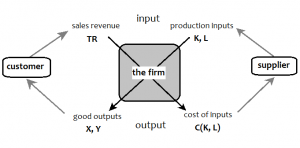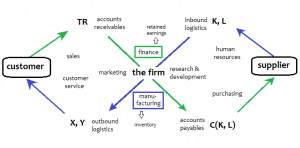When you start drilling down into proprietism, a mild paradox emerges. On the one hand, proprietism assumes that everybody is an independent contractor. On the other, I often depict proprietist firms, and describe them as operating like an ESOP, co-op, or other form of profit-sharing organization. So which is it? Is proprietism a world of sole-proprietors, or is it a world of ESOPs and co-ops with a marketing makeover? If we’re all a bunch of self-owned entities, what or whose profit is being shared?
Before answering, we should take a step back and ask ourselves “what is a firm?” The most prevailing paradigm is that a firm is formed when the transaction costs of coordinating activity through a market is higher. This is a very concrete definition of a firm that obviously involves people as the lowest common denominator, and suggests that they will organize themselves into a firm when it is more cost-effective to do so. I agree with this theory, but I think it omits explanation of a very important type of firm: single-person one. A firm “emerges,” when two or more parties “get together,” so therefore a firm of one cannot emerge.
Michael C. Jensen proposes a different but not necessarily opposing view. He describes a firm as a “nexus of contracts,” between suppliers, customers, owners, employees, and other stakeholders. I like this view because it recognizes the firm for what it is, a social fiction that doesn’t actually exist materially, and it doesn’t undermine the existence of single-person firms.
The nexus of contracts is a great description of a firm, even for the simple firms. I buy baking soda, coconut oil, Tupperware containers and spices from Wal Mart. My receipt is like a contract in that provides a description of the products I bought, what and how I paid, the date, time, and some other information about the store and how I can go about rescinding the agreement if they fail to meet my reasonable expectations. I make deodorant out of the materials I bought and package it in the Tupperware and sell it to some people. My sale will also include a receipt or invoice, which is a contract as well. I am now a collision of two contracts, so even without being legally recognized as such, I am a firm.
But what about the labor I exerting making the deodorant? A firm is a fictional arrangement, but it still involves a coordination of resources and human effort, which may not necessarily always be contractually bound.
I propose a firm as a nexus of capital, resources and labor, and to illustrate the point I will once again use the IPO model. An IPO model is a simple and basic model to explain any system. It has input, some sort of processor to turn the input into output, and it can interact by feeding its output to another system as input.
Do you remember microeconomics 101? We can use basic microeconomic terms and abbreviations to identify the inputs and outputs that make a firm. Capital is raised and used for resources or capital goods (K) and combined with labor (L) as inputs into the firm. Through the process of production, the firm manufactures and outputs products (X and Y), which are sold to customers. The customers pay money for the products, and that money is input back into the firm as total revenue (TR). That money is then reinvested back into the firm, and the output is the cost to suppliers (C[K,L]) for more capital goods and labor, which will input back into the firm, and the cycle continues. In this model, an employee is a supplier of labor: her salary is output from the firm in C[L], and she inputs her labor back into the firm as an input L.
This natural and human arrangement: the combining of resources (including raw materials and technology) with human work to output a product is a firm. Some firms, like a manufacturer, input lots of capital goods for the plant and other raw materials. Other firms, like fishermen, are using some equipment and lots of labor. Law firms and consultants use even less capital goods; perhaps they just have an office and office supplies. The price of their end product X (the legal advice or professional consultation), is mostly based on the level of expertise held by those who contributed labor.
The government that allows firms to operate may have taken on many different forms and theories over the course of human history, but the basic nexus has remained intact. The firm has itself evolved over time, and in modern society we have assigned departments to refer to different functions within that nexus.
Most firms start with some sort of product idea. Perhaps there is some market research that concluded the product would be profitable in its intended market, and that if the function of a marketing department. Perhaps the firm started with a focus on a brand new product that has never been made before, or a brand new manufacturing process for an already existing product. This is the role of research and development departments. Once we have done sufficient research, we raise capital to finance the cost of capital goods and labor inputs. The finance department’s job is to manage those funds, accounts payables and payroll departments manage the outgoing funds to suppliers and workers. Purchasing, inbound logistics, and HR departments manage the incoming capital goods, resources, and labor. The inputs of capital goods, resources, and labor all combine in a production or manufacturing process managed by production or operation departments. Finally, products X and Y are the end result. Sales uses research from marketing and finds viable customers for X and Y, and customer service and outbound logistics coordinate the ordering and delivery of X and Y to those customers. Accounts receivables collects the sales from the customers, and the cycle starts all over again.
With the firm now redefined as a nexus of capital and labor, I’m ready to address the question originally posed: what profits are being shared if, in a proprietist system, there is no clear line drawn between a company and its partners?
Let’s turn our attention to the two end-products: X and Y. No matter what you’re doing in an economy, you have some end product X. In the case of the example earlier with me as a one-person firm, the homemade deodorant is X. The end-product X could also represent your labor; if Nathaniel is a logistics supervisor, Nathaniel’s supervision of a team of logistics analysts is X. In that case, there is another X somewhere along the supply chain in which he is also contributing. Maybe Nathaniel works for a logistics firm and is providing a logistics service to another company that sells a widget which ultimately gets sold in stores to consumers.
Here’s the idea: tiny percentages of the selling price of that final consumer product get distributed to everyone who contributed to it.
Kim is a retail associate and it is decided that her selling service is worth 5% the selling price of the widgets she sells. This is similar to commission. Ashley operates a machine that mines minerals, some of which get used to make the widgets that Kim sells, and some of which get used in other products. Ashley’s cut of every widget that Kim sells would be significantly smaller, say 0.1%, but Kim earns based on the sales of all the final products in which she partakes. So Kim earns a lot on a few end-products, and Ashley earns a little with a lot of end-products.
This scheme, which would undoubtedly require extremely agile information systems and planning, would align the entire economy towards consumer products. The obvious technical challenge would be deciding the exact percent share that each person gets. Louis Kelso, who invented the employee stock ownership plan, proposed that a worker responsible for contributing 10% of an operation deserves to keep that 10% share as the company grows. ESOPs function like this; the idea is that employees are compensated with shares of stock that will grow as the company does. Likewise, we can work out an arrangement in which a worker has a personal and permanent invested interest in the success of the end-product to which he or she contributes.
Conclusion
On the question of how proprietism is structured, it could look like a network of sole-proprietorships, and the profit-sharing could look like an ESOP or co-op. The stock each worker receives could be based on sales of the end-products that that worker touches or to which he contributes. This may seem like a complex arrangement, but the structure could solve many modern problems in the realms of compensation and inequality. Additionally, it would align all a product’s stakeholders towards the long-term success of that product, rather than incentivize short-term gains and cost-cutting.



